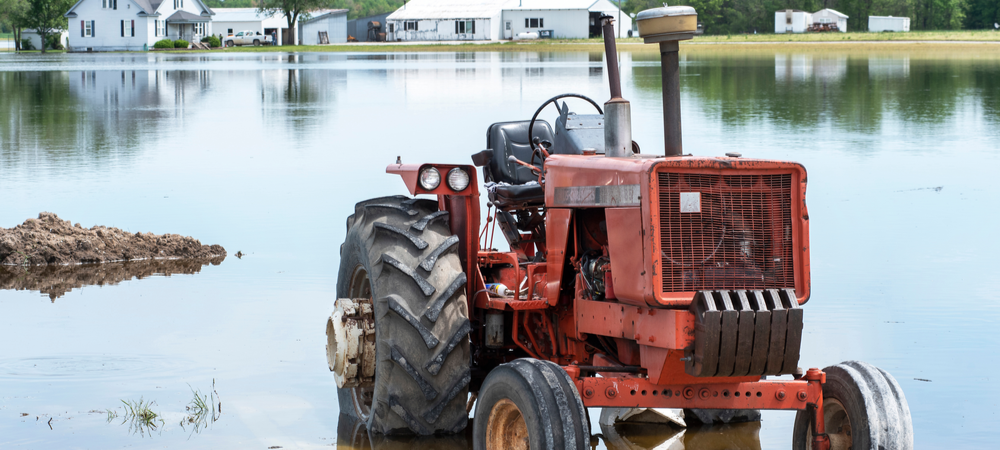 A tractor sits stranded in a flooded field in Winfield, Missouri. Image source: Jon Rehg/Shutterstock, 2019.
A tractor sits stranded in a flooded field in Winfield, Missouri. Image source: Jon Rehg/Shutterstock, 2019.
By Naim Kapucu and Fernando I. Rivera
Depictions of rural life tend to romanticize certain qualities—the remoteness, the rustic charm, the freedom from the bustle and crowds of cities. These qualities might be appealing, but they are also what make rural communities especially vulnerable to the impacts of hazards and disasters. Because of they lack the financial and material resources that are available in urban areas, rural areas must think ahead and work collaboratively to build their disaster resilience.
Resilience, especially community resilience, has become a critical focus for emergency managers and policy makers concerned about hazard risk and vulnerability in rural areas. Resilience is usually defined as the capacity to recover quickly from adverse external impacts, such as disasters. This capacity can be built or strengthened by using hazard mitigation to reduce or prevent losses, as well as implementing preparedness activities that improve the effectiveness of response.
For rural communities, however, building resilience is difficult for a number of reasons. Smaller tax bases can cause financial constraints, limited population can affect the way state and local mitigation and recovery funds are distributed, and training opportunities and equipment for disaster response might also be lacking. Reduced access to technology can prevent communication before, during, and after disasters. These obstacles can create significant difficulties in designing and implementing hazard mitigation plans and practices.
Vulnerabilities specific to rural areas might also play into a lack of resilience. Rural communities often consist of low-cost homes (such as mobile homes), individuals with lower incomes and lower education levels, relatively older populations, and people whose livelihoods are dependent on resource-focused occupations, such as farming.
Because of these limitations, it’s important for rural emergency organizations to reduce the reliance on federal resources and encourage community responsibility in addressing hazards. Typical funding and response avenues—such as formal disaster declarations or other types of mutual assistance agreements—can be almost impossible to access for rural communities and neighborhoods. As such, assistance to these areas might not arrive in timely manner, as we saw after Hurricane Katrina in Louisiana and Texas in 2005 and Hurricane Irma in Florida in 2017.
To become more resilient, it’s critical that rural communities invest in building their capacity and partnering with urban areas. Because many rural locations can be considered part of urban-rural interface, opportunities exist to leverage the resources of their more populous neighbors. Our book, Disaster Vulnerability, Hazards, and Resilience: Perspectives from Florida, highlights lessons we learned in that state about building resilience. These included how the rural-urban interface is important for disaster resilience in vital economic sectors, such as agriculture and tourism, as well as how important farm worker activities and response actions are to community resilience.
Our earlier research on rural disaster resilience focused on how communities can increase resiliency using asset-based planning, policy interventions, and collaborative governance mechanisms—including resource sharing with urban area agencies. Memorandum of agreements and collaborative engagement with nearby urban areas can be impactful in developing rural resilience, as well. Communities we examined either exhibited strong social capital and shared resources informally or they developed local mutual assistance arrangements to share resources. Taking the initiative to draft memorandum of understandings and mutual assistance compacts can help in build local capacities. Working closely with county-level government, which often act as the administrative arm of the state governments in disasters, can also help rural communities reduce costs and more effectively address impacts.
These findings point to critical implications for the specific issues that impede disaster resilience in rural communities. Collaborative culture and leadership perspectives are crucial for building rural community capacity and effectively managing emergencies. If such collaboration is not attentively implemented, there is a potential to create new vulnerabilities, lack the resources to address impacts, and ultimately be less resilient to disaster.

Naim Kapucu is Pegasus Professor of Public Administration and policy and former director of the School of Public Administration at the University of Central Florida. His research focuses on emergency and crisis management, decision making in complex environments, network governance, and leadership. He is co-editor of Disaster Resiliency: Interdisciplinary Perspectives, co-author of Disaster Vulnerability, Hazards, and Resilience: Perspectives from Florida, and Network Governance: Concepts, Theories, and Applications.